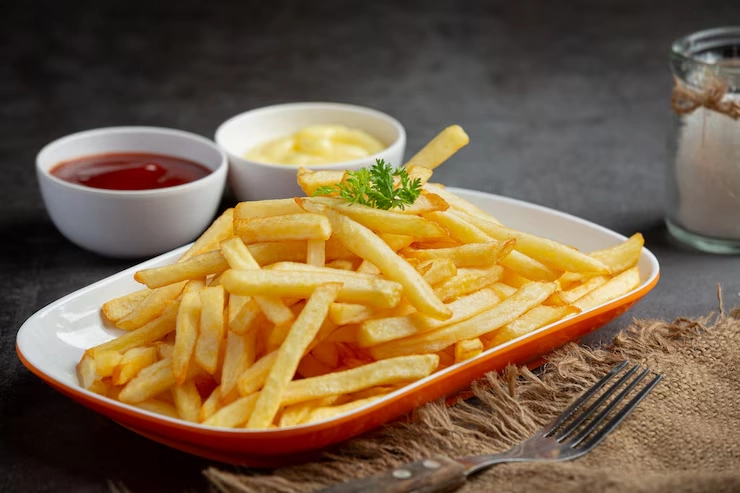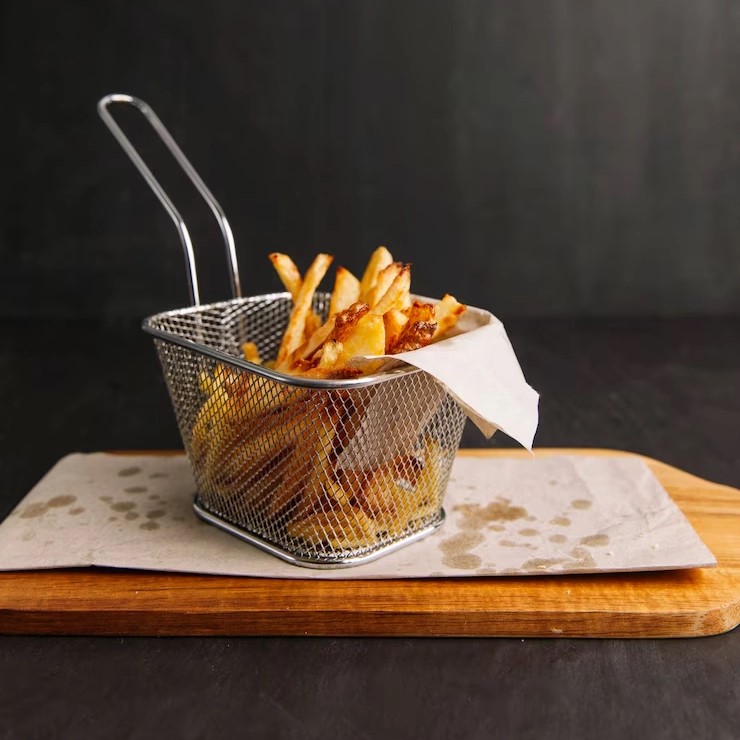5 Days a week from 8:30 am to 5:30 pm
Why Blanching is Essential for Consistently Perfect French Fries?
Blanching is the secret to great French fries, giving them a crunchy feel and bright color. This method uses science to improve taste and sameness. Learn why blanching is important, how it helps frying, and the best ways to do it. Find out how SIMPLE offers top-notch frying baskets for perfect fries every time.
What Makes Blanching Crucial in French Fry Preparation?
Blanching, a quick cooking step, is key for making fries like those in restaurants. By shortly boiling potato sticks before frying, blanching changes their feel, taste, and look, setting up steady results. Blanching means briefly cooking potato sticks in hot water, usually at 160–185°F. This step makes starches on the potato’s outside sticky, forming a shield that stops oil from soaking in during frying. It also stops tiny parts that cause darkening and spoiling, keeping fries fresh. By managing starches and water, blanching makes fries cook evenly. They get a crispy outside and soft inside. Blanching softens the potato’s inside, making it tender and fluffy after frying. The sticky starch layer turns into a crisp cover, giving the classic crunch of great fries. It also boosts taste by cutting raw potato flavor, letting spices stand out. This step keeps fries from being too oily or too dry, balancing feel and taste for a fun eating moment. Sameness matters in busy kitchens, and blanching ensures all fries are alike. It pre-cooks potatoes to a similar point, cutting differences in frying time and oil soaking. Whether making a small batch or a big order, blanched fries keep the same bright color, crunch, and fluffiness. This dependability is vital for restaurants wanting to please customers with every dish.
How Does Blanching Improve the Cooking Process?
Blanching makes frying easier, fixing common problems and improving the final fries. It prepares potato sticks for frying, leading to better outcomes with less work. Potatoes have lots of water, which can make frying uneven and cause oil to splash. Blanching takes away extra water from the potato’s outside, helping fries cook more evenly. Less water means less oil gets soaked up, making fries less greasy. This also keeps oil heat steady, improving frying speed and making oil last longer in busy kitchens. Blanching helps create the famous golden color of French fries. By stopping darkening parts, it keeps fries from turning gray or too brown during frying. The sticky starch layer gets crunchy in hot oil, making a crisp outside that stays firm even when cool. This makes fries look tasty and stay crunchy, improving their look and feel. Soggy fries often come from too much water or wrong cooking. Blanching fixes these issues by pre-cooking the potato’s inside and cutting surface water. This stops fries from getting limp or oily. It also reduces sticking, making it easier to fry big batches without clumping. With blanching, kitchens can avoid usual problems and make high-quality fries every time.
|
Blanching Benefit |
Impact on Fries |
|
Water Reduction |
Less oily, even frying |
|
Stopping Darkening |
Bright color, no early browning |
|
Sticky Starches |
Crunchy outside, soft inside |
|
Sameness |
Same feel and taste across batches |
What Are the Steps to Properly Blanch French Fries?
Proper blanching needs careful setup and methods to get the best fries. Follow these steps to master the process and make perfect fries. Start with starchy potatoes like Russets for the best feel. Peel if you want, and cut into even sticks, usually ¼ to ½ inch thick, to cook evenly. Wash the sticks in cold water to remove extra starch, which stops sticking and boosts crunch. Dry them well with a clean cloth to cut water before blanching. Blanching needs exact heat and timing to prepare fries without fully cooking them. Heat water to 160–185°F in a big pot. Add potato sticks in small groups to keep the heat steady. Blanch for 3–7 minutes, based on thickness, until slightly soft but not fully cooked. The fries should stay firm. Use a thermometer to check water heat, as too much heat can make fries mushy. Right after blanching, move fries to an ice bath or cold water to stop cooking. This keeps their feel and prevents overcooking. After 2–3 minutes, drain and dry well with paper towels. Dry fries fry better, soaking up less oil and getting very crunchy. At this point, fries can be stored in the fridge for later frying or fried right away.
|
Blanching Step |
Key Details |
|
Potato Setup |
Use Russets, cut evenly, wash starch |
|
Water Heat |
160–185°F |
|
Blanching Time |
3–7 minutes, based on thickness |
|
Cooling/Drying |
Ice bath, dry well for crisp frying |
Why Choose SIMPLE as Your Reliable Frying Basket Supplier?
SIMPLE is a trusted name in kitchen tools, offering high-quality frying baskets that improve French fry making in professional and home kitchens. SIMPLE’s frying baskets, found at their frying basket category, are built for strength and speed. Made from top-grade steel, SIMPLE’s baskets resist rust and handle high frying heat. The strong wire build ensures they last, even in busy restaurant kitchens. Items like the stackable wire frying basket are made to endure heavy use without bending. SIMPLE baskets have fine mesh or hole designs to ensure even oil flow and fast draining, stopping soggy fries. Comfortable handles, like those on the long-handle frying basket, stay cool and make handling safe. Dual hooks and stackable designs improve work in high-volume kitchens. SIMPLE’s baskets save time with quick oil draining, cutting frying time and oil waste. Safe handles and strong builds reduce accidents. They work for fries, onion rings, and other fried foods. Steel is easy to clean in a dishwasher, making upkeep simple. These strengths make SIMPLE baskets, like the heavy-duty frying basket, a top pick for cooks aiming for steady, high-quality fries.
Final Thoughts on Mastering Perfect French Fries
Blanching is the key to always-perfect French fries, delivering crunchy, bright results every time. By understanding its science and using proper methods, you can improve your frying skills. Pairing this process with top-quality tools, like SIMPLE’s frying baskets, ensures restaurant-level results in any kitchen. Master blanching and turn your French fries into a crowd-pleasing treat.
FAQs
Why is blanching necessary before frying potatoes?
Blanching helps make better fries in several ways. It cooks the potato pieces a little first, which makes their outside sticky and removes some water. This gives you crispier fries with a nice golden color. The hot water bath also stops the potatoes from turning brown too fast, so they keep looking and tasting good. When done right, blanching makes sure all your fries turn out the same – not too greasy or soft.
Can I skip blanching and still achieve crispy fries?
You might wonder if you can make good fries without blanching them first. The truth is, skipping this step usually gives worse results. When potatoes aren’t blanched, they stay too wet inside. Their natural starches don’t get the chance to become sticky enough. This often leads to fries that are soft in some places and hard in others. Some people try cooking them twice in oil to help. But honestly, nothing works as well as taking the time to blanch them properly first. If you want fries that are crunchy all over and look like they came from a restaurant, blanching is the way to go.
How does blanching affect the nutritional value of potatoes?
Blanching has little effect on potato nutrition, keeping most vitamins and minerals. It may cut some water-based nutrients, like vitamin C, but the loss is small. The process improves feel and taste without greatly changing health benefits.



